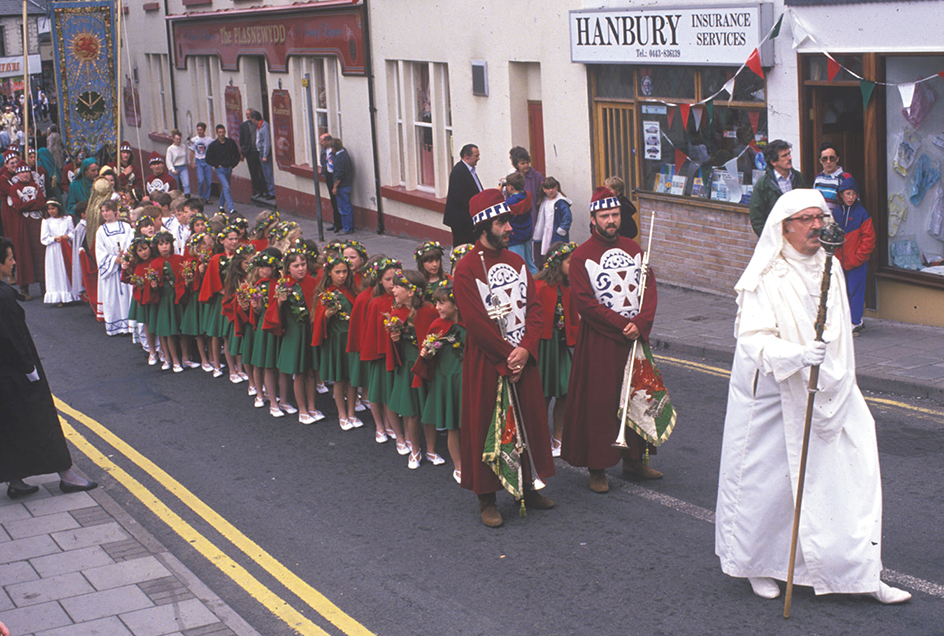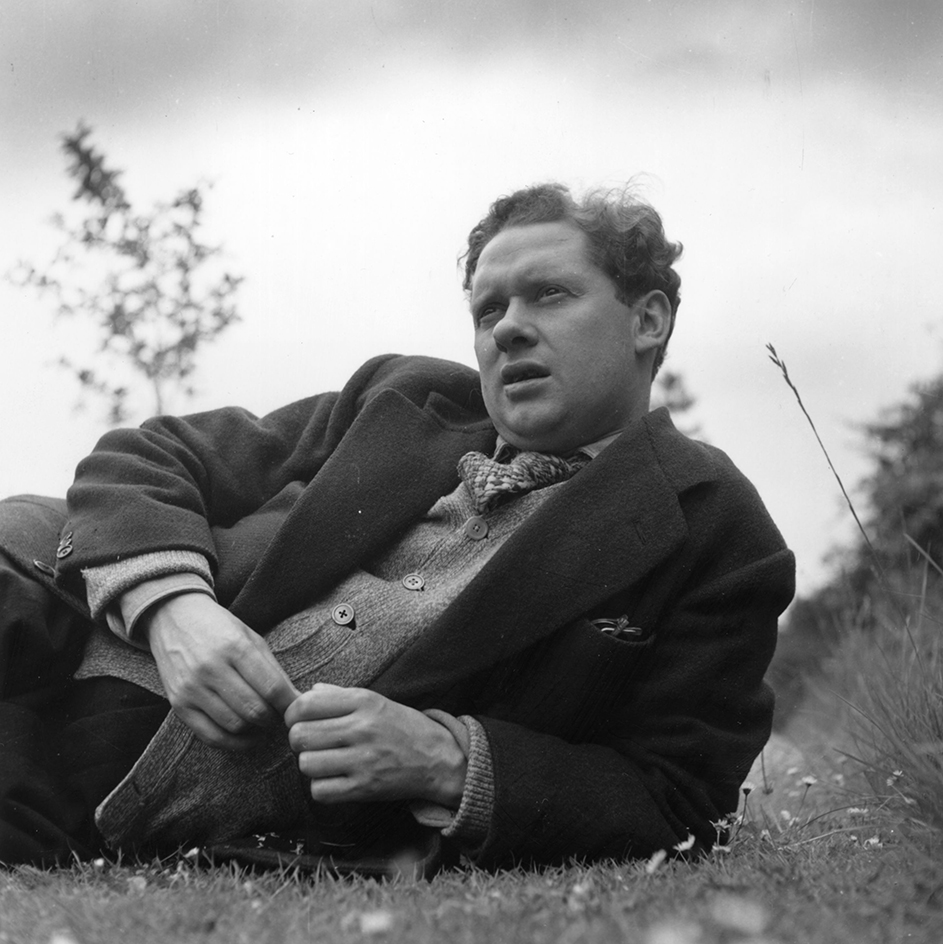Welsh literature is the collection of writings of the people of Wales. The traditions of Welsh literature are among the oldest in Europe and date back more than 1,000 years to the bards (poet-singers) of the early Middle Ages. See Bard.
The ancient traditions of the bards still influence Welsh writers today. But Welsh authors also experiment with new literature forms and incorporate the influences of international writers. Since the early 1900’s, many Welsh writers have written literature in English rather than Welsh, often calling themselves Anglo-Welsh.

Characteristics of Welsh literature.
Up to the end of the 1500’s, many Welsh poets described the social life of their times. They described preparations for war, raids, feasting, halls and castles, food and wine, and clothes and manners of the time. They also described their relationships with the people of the times. After the late 1800’s, many writers wrote novels about the contemporary social scene and about Welsh history.
Throughout the history of Welsh literature, writers have drawn on important religious themes. Since the religious awakening of the 1700’s known as the Methodist Revival, they have often expressed religious themes in poetry with intense personal feeling.
There is much grief in Welsh poetry, but there is also much joy in poems about love, friendship, and the beauty of the world. The feeling of longing—for home, for past joys, for vanished friends, or for one’s country—is represented in Welsh by the word hiraeth. Many Welsh people left Wales to make their living elsewhere, and some Welsh poetry expresses this longing for home and country.
Language and form.
Welsh poets established a number of poetic meters (rhythms) and forms in the Middle Ages. Since then, some Welsh poets have experimented with new verse forms, but many have continued to use the basic traditional meters. One example is the englyn, a short poem or stanza usually containing three or four lines. Other traditional forms still in use today are the cywydd, a form of ode written mainly in seven-syllable couplets, and the awdl, traditionally considered the highest and most dignified kind of poem.
Welsh poets often pay much attention to the forms of lines and stanzas as well as to the sound of words. Poets have developed a complex system of alliteration and internal rhymes known as cynghanedd. In its simplest form, cynghanedd involves repeating or echoing, in the last part of a line, the series of consonant sounds used in the first part of the line. Rhyme also plays an important part in cynghanedd.
Early prose.
Welsh prose has a long tradition, going back to the Middle Ages. By the 900’s, Welsh prose writers were skilled enough to deal with a variety of subjects. Storytellers were important in early Welsh society. The most famous stories are recorded in the Four Branches of the Mabinogi. Scholars do not know who wrote down these stories. The Mabinogi consists of four ancient tales. Since the mid-1800’s, they have often been grouped with seven other early Welsh tales to form what is called the Mabinogion.
After 1500, prose writers turned more and more to religious subjects, often translating texts from other languages into Welsh. In 1588, the Bible was translated into Welsh. Many scholars believe that this ensured the survival of the Welsh language until today.
Early poetry.
The earliest known Welsh poetry is the heroic verse of Aneirin and Taliesin. These two poets composed their poetry mainly in the late 500’s. Aneirin probably composed a poem called “Y Gododdin” in about 600. The poem tells of an attack on the Angles at Catterick in what is now northern England by a force of trained warriors.
From the 600’s to the 1100’s, poets wrote heroic, elegiac (mourning), and religious verse. In one series of poems, a poet expressed the grief of Llywarch the Old for the loss of his sons and the coming of old age. Great professional court poets of the 1100’s included Meilyr Brydydd, Gwalchmai ap Meilyr, and Cynddelw Brydydd Mawr. In the poem “Gorhoffedd” (meaning “boasting” or “proud delight”), Gwalchmai wrote of his love for women, nature, and war. Other great poets of this time included Owain Cyfeiliog and Hywel ab Owain Gwynedd.
In the 1300’s, poets wrote of their patrons, love, and nature. Dafydd ap Gwilym, one of the greatest Welsh poets, wrote with gaiety and passion about women. He also wrote fine poetry in response to nature in all its moods. He was a master of humor and satire. Other poets of the 1300’s and 1400’s included Iolo Goch, Sion Cent, Guto’r Glyn, Dafydd Nanmor, and Dafydd ab Edmwnd. The poetry of Tudur Aled, who wrote in the late 1400’s and early 1500’s, is sometimes marked by uncertainty about the social and political changes of his time.
Poetry and prose after 1500.
In the 1500’s, many writers turned from classical meters to free meters. They also composed poems in stanza forms and set them to music, often English tunes. Edmwnd Prys translated the Psalms and set them to the meter of an old carol. After the Reformation, a religious movement of the 1500’s that led to Protestantism, writers turned out many prose works on religious and humanist subjects. They also compiled dictionaries and grammar books. Welsh prose became more polished and complex in structure.
In the 1500’s and 1600’s, many poets continued to compose verses designed to be sung with the harp. Many of these verses, which are called penillion, are well known today. Religious writers used penillion as a simple way of conveying their message to the people. Huw Morus, a poet of the 1600’s, blended the word-music of cynghanedd with his song lyrics.
During the 1700’s, writers produced many prose works. These books included such classics as Gweledigaetheu y Bardd Cwsc (The Visions of the Sleeping Bard, 1703) by Ellis Wynne and Drych y Prif Oesoedd (The Mirror of the First Ages, 1716; revised edition, 1740) by Theophilus Evans. The brothers Lewis, Richard, and William Morris and their friends combined scholarship, the study of the past, personal experience, and tradition in their work. They were leaders in what became known as the Welsh literary renaissance. The group applied non-Welsh ideas to the Welsh tradition. They admired the simple penillion as well as the old heroic poetry. One of the most accomplished poets was Goronwy Owen. Other great poets of the 1700’s included the hymn writers William Williams of Pantycelyn in Carmarthenshire (who also became known as Williams Pantycelyn) and Ann Griffiths. Both took part in the Methodist Revival, a movement in Protestant Christianity during the 1700’s that emphasized personal faith and practical good works.
In the 1800’s, the National Eisteddfod, a festival of Welsh poetry and music, and the governing body of Welsh poets known as the Gorsedd (throne) increased in importance. The two institutions had a growing influence on the traditional forms of writing. Two outstanding poets of the 1800’s were Eben Fardd (the pen name of Ebenezer Thomas) and Islwyn (the pen name of William Thomas). Islwyn was also a great hymn writer. His view of nature was similar to that of the English Romantic poet William Wordsworth. The poet Ceiriog (whose full name was John Ceiriog Hughes) wrote lyrics that are still read today. Popular prose works of the 1800’s include folk tales collected and adapted by Glasynys (the pen name of Owen Wynne Jones). Daniel Owen became the father of the Welsh novel during this time.
In the late 1800’s and early 1900’s, Elfed (the pen name of Howell Elvet Lewis) and John Morris-Jones wrote lyric poetry in a new manner. They combined knowledge of Welsh traditions with an awareness of European poetic developments.
Prose and poetry in the 1900’s and 2000’s.
Since the union between Wales and England in the 1500’s, more and more Welsh people have learned to speak English as well as Welsh. Many English-speaking people have migrated to Wales. Today, those who speak only English outnumber those who speak Welsh. Writers may reach a greater public and receive greater financial rewards by writing in English. Despite this, many writers continue to write in Welsh and have their work translated into English and other languages. Some Welsh writers use dialects of English. Some poets, such as Gwyneth Lewis from Cardiff, write in both Welsh and English.
In the 1900’s, W. J. Gruffydd and T. Gwynn Jones continued to develop lyric poetry. The lyric poet R. Williams Parry wrote with sensitivity, acute observation, and a mastery of form and language. T. H. Parry-Williams combined the traditional devices of Welsh poetry with the language used in everyday speech.
Welsh poets today use both modern and traditional forms. Such poets as Alan Llwyd, Dic Jones, and Gerallt Lloyd Owen have ensured that the cynghanedd tradition remains vibrant. Since the end of the 1960’s, many Welsh poets, such as Iwan Llwyd and Menna Elfyn, have written political poetry. The Welsh poet Tony Conran and the American poet Joseph Clancy have translated much Welsh-language poetry into English.
In the English language, one of the best-known poets from Wales is Dylan Thomas, who wrote some of the most eloquent verse in modern literature. Other poets of Welsh heritage include William Henry Davies, who lived as a beggar and wrote of nature and the hardships of poverty. Edward Thomas, who was killed in battle during World War I (1914-1918), used themes of nature and the English countryside in his writings. Alun Lewis, who was killed during World War II (1939-1945), wrote in the Romantic style, favoring nature and stressing personal freedoms. R. S. Thomas, a priest in the Church of Wales, was perhaps the finest poet from Wales in the 1900’s. He wrote many religious poems, but also poems about the threat to the Welsh language and Welsh culture.

Outstanding Welsh-language fiction writers of the 1900’s include Kate Roberts, D. J. Williams, Caradog Prichard, and Bobi Jones. The works of Saunders Lewis include criticism, fiction, drama, and verse. He was one of the founders of the Welsh national party, Plaid Cymru. In the 1980’s and 1990’s, a younger generation of writers, including Wiliam Owen Roberts, Robin Llywelyn, Mihangel Morgan, and Angharad Tomos, brought new elements into Welsh fiction.
The painter and writer David Jones was of Welsh heritage. His best-known work is the free-flowing historical poem “The Anathemata” (1951). Major English-language fiction writers of the 1900’s include Richard Llewellyn, Gwyn Thomas, and Emyr Humphreys. Llewellyn’s novel How Green Was My Valley (1939) became an international best seller. The novel is a portrait of a Welsh mining family. The novelist, short-story writer, and English professor Gwyn Jones wrote throughout the middle and late 1900’s. He founded a literary journal, The Welsh Review, in 1939. Working with the scholar Thomas Jones, he translated the Mabinogion (1948). His Collected Stories was published in 1998.
